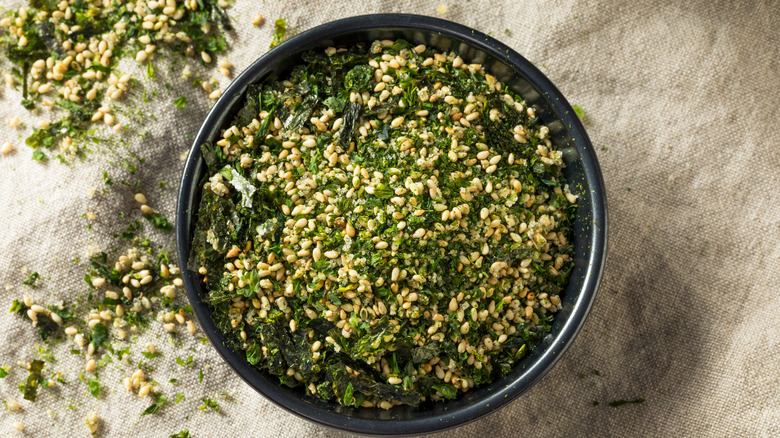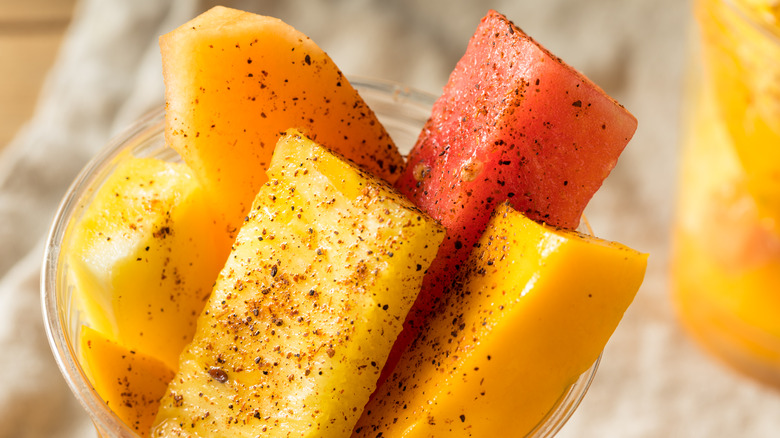Wolfgang Puck's Top Tip For Seasoning Cold Food Vs. Hot Food
"Seasoning" is both a noun and verb, referring to the salt, herbs, and spices used to boost flavor in cooking, according to MasterClass.They come in many varieties across the five-taste spectrum and are used throughout world cuisine and in meals from breakfast to dessert. Seasonings come from minerals (salts), whole or partial parts of plants and fungi, and even animal products in the case of anchovy paste and bonito flakes. Seasonings you might not have heard of include seaweed (as in furikake), salt substitutes (per Consumer Reports), and Pluck, made with freeze-dried, grass-fed animal organ meat.
But did you know that when you season the food matters? Foods that traditionally require copious amounts of seasoning include many Indian recipes, where spices are often added during and after cooking. Likewise, with barbecued and cured meats, pre-cook seasonings are often measured by the tablespoon — with heavy salting or brining required to retain moisture over long cooking and aging periods. But there's also a difference between seasoning practices for cold foods and hot foods. Chef and restaurateur Wolfgang Puck has professional advice to help you in this department.
Cold food clamors for seasoning
Wolfgang Puck points out (via MasterClass) that cold food can demand more seasoning than hot food. He states, "The palate really receives the flavors of cold food much slower...So cold food should be seasoned a little heavier than hot food." Puck explains that when you taste something like a bowl of steaming soup, you'll be able to notice immediately if it leans too far in any spice direction. This is partly because heat permits spices to release their tasty essential oils, to the point that he even recommends toasting spices before use, and likewise, America's Test Kitchen found that blooming spices in oil enhances their flavor.
If you're not convinced that cold water can go to work the same way, consider iced tea or cold brew coffee, both of which involve a low, slow seep that results in a rich yet mellow flavor. It simply takes more time for the flavors to develop in the absence of heat. Therefore, it makes sense that cold food can use a seasoning leg-up. In certain uncooked dishes like sashimi, the point is to allow the clean purity of the ingredients to come through. But in recipes where naturally bland foods are used — particularly vegetables, grains, and mild meats — a heavier seasoning hand is required. Here are some examples.
Superbly-seasoned cold dishes
According to Isabel Eats, a favorite snack among the Mexican population is cold fruit sprinkled with Tajin and doused in chamoy. Tajin is a dry seasoning made from chili, lime, and salt. There's sweet, sour, spicy, salty and then there's chamoy, which combines all these flavors to great effect in a thick red syrup. Together, these seasonings elevate fruit to create a refreshing snack for hot days. In Asian cuisine, you'll find dishes like spicy cold tofu and cold sesame noodles, which use intensely delicious sauces for blending heat, acid, sweetness, and umami on a mildly-flavored backdrop.
Hearty coleslaw requires home cooks to be liberal with dill, celery seed, and other spices to create this popular summertime side dish. Chicken salad absorbs copious amounts of seasoning — including salt and pepper, herbs, and even curry powder in the coronation version (per BBC goodfood). A little salt and sugar on a raw tomato bumps it up, and don't forget to appropriately dress up your pickled fruits and vegetables. Vinegar is a valuable ally in seasoning your cold dishes. So when there's a season, turn, turn to your spice cabinet to make your cold and hot recipes as exceptional as Wolfgang Puck's.


